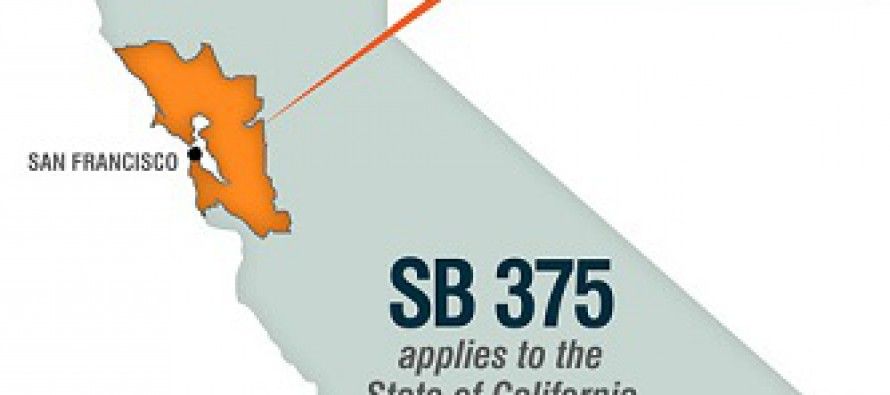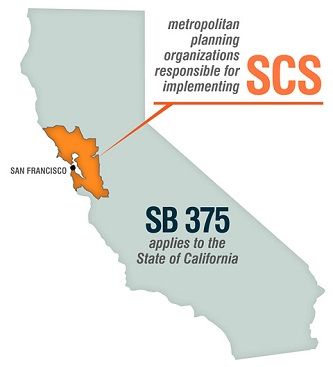57% of CA infrastructure $ on mass transit? More, more, more!

 In 2008, California enacted SB 375, the most important state law you never heard about. It was Senate leader Darrell Steinberg’s bid for the sort of green reverence that Arnold Schwarzenegger enjoyed because of 2006’s AB 32.
In 2008, California enacted SB 375, the most important state law you never heard about. It was Senate leader Darrell Steinberg’s bid for the sort of green reverence that Arnold Schwarzenegger enjoyed because of 2006’s AB 32.
SB 375 (Chapter 728, Statutes of 2008) directs the California Air Resources Board to set regional targets for reducing greenhouse gas emissions. The new law establishes a “bottom up” approach to ensure that cities and counties are involved in the development of regional plans to achieve those targets.
SB 375 builds on the existing framework of regional planning to tie together the regional allocation of housing needs and regional transportation planning in an effort to reduce greenhouse gas (GHG) emissions from motor vehicle trips.
San Diego County has become the first major county to file its SB 375 compliance plan. So far, there have 德州扑克 been two ongoing court fights over whether the county’s long-term infrastructure-improvement planning does enough to push the region to reduce greenhouse-gas emissions, as mandated by Steinberg’s law.
The county had to file its plan at the same time it was formulating its long-term approach to traffic congestion. Recent improvements to Interstate 15 have paid huge dividends. This made San Diego Association of Government officials even more committed to an expansion of Interstate 5 from the Del Mar area north to Camp Pendleton. Work is supposed to begin next year. Traffic engineers concluded there was no single project that would do anything close to relieving the congestion that would be accomplished with the I-5 improvements.
But that upgrade is now imperiled because greens have won at the appeals court level in both of the legal fights over the adequacy of San Diego County’s long-term plans.
What should 57% of infrastructure $ go to?
So what is one of the key fights in the legal battles over the county’s plan?
The contention of one side that spending on mass transit should start at 38 percent of infrastructure spending and reach 57 percent from 2040-2050.
There is no history of mass transit being popular anywhere but in packed-in cities like Tokyo and New York. California is not Tokyo or New York.
So how could those insane tree-huggers propose that 57 percent of future infrastructure spending in the San Diego region go to mass transit?
Bulletin: That isn’t what the Sierra Club supported. It’s what the county proposed and the Sierra Club and many other environmental groups rejected as unacceptable.
This is crazy enough on its face. But when you think about it more deeply, it becomes absolutely ridiculous. A state law is pushing local governments to assume mass transit will be the most logical way to move people around in a spread-out state — in 2040! This is happening even though there are so many promising energy-technology initiatives in the works — and even though there have been plenty of concrete gains since 2008.
Cars get cleaner as freeways de-emphasized
I had more on this issue in a Tuesday U-T San Diego editorial.
California is not the boroughs of New York City writ large. It is a sprawling state, and that is never going to [embrace mass transit] so long as housing is cheaper on the edges of the state’s population centers. Cars are infinitely more convenient for a typical day’s requirements — commuting to work; running errands on lunch breaks; getting kids to school, music classes, sports practice or jobs.
But instead of acknowledging this immense convenience factor, greens seek policies that would create mass inconvenience. The Interstate 5 experience in North County is already often bad; if the freeway upgrade is blocked, it will become routinely horrible. For people who hate cars, this amounts to a desired result.
They think this way even as we see rapid progress in developing far cleaner cars — and not just the Prius. As The New York Times reported Sunday, the “once-distant promise of clean, affordable hydrogen-powered cars is starting to become a reality,” with very positive implications for global warming. Pragmatic environmentalists will see this as good news. But not those who view cars and freeways the same way that most people think about bubonic plague.
Here’s a link to the NYT story on hydrogen-powered cars.
Related Articles
L.A. Times story on pension reform: Dumb de dumb dumb
March 11, 2013 By Chris Reed The Los Angeles Times reported over the weekend that public employee unions are suing
Why can't CA be N.D.?
John Seiler: Numbers released today show that California’s unemployment rose in August, to 12.4% from 12.3% in July. I guess
Govt. robs my paycheck even more
Jan. 15, 2013 By John Seiler This morning my first paycheck of the year was plunked into my bank account.


